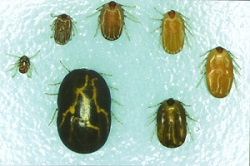Cattle tick incursion via a horse entering Victoria from interstate
Sarah Sloan, Acting Policy Officer (Epidemiology)
Alison Lee, Principal Veterinary Officer – Chief Veterinary Officer Unit
Cattle ticks are important economic parasites affecting the cattle industry in northern Australia. They can transmit the protozoal and rickettsial organisms that cause tick fever (babesiosis and anaplasmosis), potentially resulting in high mortality rates in cattle. Cattle ticks are not endemic in Victoria, due mainly to climatic conditions unsuitable for cattle tick survival. However, treatment of tick-infested animals and quarantine of areas potentially contaminated with ticks or their larvae is essential to prevent any chance of their survival and spread, particularly to cattle.
Agriculture Victoria recently responded to a confirmed detection of cattle tick (Rhipicephalus australis) in a horse that arrived from Queensland. The horse departed Rockhampton in early July and arrived at the destination property in northern Victoria five days later. The property owners noticed the presence of ticks on the horse and contacted their local veterinarian for treatment advice. Agriculture Victoria was contacted shortly after, as the initial treatment failed to control the ticks.
A number of ticks were forwarded to Agribio Crop Health Services for identification purposes. They were confirmed to be Australian cattle tick (Rhipicephalus australis), also previously referred to as Boophilus microplus, and more recently, Rhipicephalus microplus.
The cattle tick spends the parasitic stage of its life on the one host, with cattle generally the main host. However, they may also be found on horses, goats, sheep, deer, camelids and buffaloes. The parasitic stage lasts approximately 21 days during which time the tick changes from a larvae to a nymph and finally an adult. Adult females feed slowly for a week before rapidly filling with blood just prior to detachment. They then drop onto pasture, lay eggs and die. Eggs hatch to produce larvae, which infest the pasture until picked up by a suitable host. This non-parasitic stage can vary from approximately two months in summer, to six to seven months over winter. Males feed occasionally, but do not fill with blood. They wander over the host for two months or more, mating with females.

A treatment notice was issued to the owner of the horse, and the potentially contaminated facilities and paddocks were placed under quarantine. There were a number of horses on the property but fortunately no cattle. The unaffected horses were located in different paddocks to the tick infested horse, with a reasonable separation between them. Despite low risk of contact with the tick infested horse, it was recommended that all horses leaving the property were treated with an effective acaricide prior to their departure. As there is now resistance to many acaricides, local animal health staff continued to monitor the property until they were confident the treatment of the affected horse was effective.
The transporter of the horse was also issued with a notice requiring decontamination of the transport vehicle. Decontamination was undertaken under the observation of local animal health staff. As infestation with cattle tick is a notifiable disease in Victoria, a full investigation was conducted. Tracing information was obtained from the owner of the horse transport company to ensure no other horses were likely to have been infested with cattle ticks.
It is imperative that veterinarians who suspect animals may be infested with cattle ticks in Victoria, notify Agriculture Victoria as soon as possible. Their presence can then be confirmed (or excluded), affected animals treated quickly, and take steps taken to prevent the spread of ticks, which is of particular importance to the Victorian cattle industries.